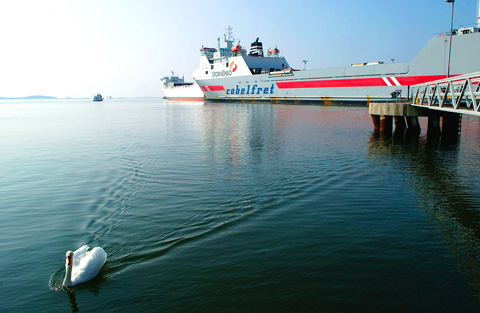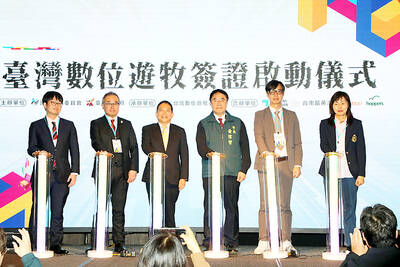Something unusual is happening in Swedish waters. Crews docking at the Port of Gothenburg are turning off their engines and plugging into the local power grid rather than burning diesel oil or sulfurous bunker fuel — a thick, black residue left over from refining oil.
“I always knew these extremely dirty bunker fuels were helping produce acid rain that falls so heavily over this part of Sweden,” said Per Lindeberg, the port’s electrical manager and an avid fisherman. “I was very happy when we could switch off the ships.”
Similar high-voltage technologies have been introduced at Zeebrugge in Belgium, and in Los Angeles and Long Beach in California. But as at Gothenburg, only a small fraction of ships are equipped with plugs, so the benefits from shore-side electricity so far have been limited.

PHOTO: NY TIMES NEWS SERVICE
And despite the growing availability of cleaner technologies, the shipping industry has made little progress toward becoming greener, even as traffic grows heavier on existing routes and new routes open up in the Arctic. Indeed, the most recent efforts to tackle the problem have met resistance — less from the shipping industry, however, than from the big oil companies that supply the dirty fuel.
Shipping is responsible for about twice the emissions of carbon dioxide as aviation — yet airlines have come under greater criticism. Particles emitted by ships burning heavy bunker fuel, described by some seafarers as “black yogurt” for its consistency, also contain soot that researchers say captures heat when it settles on ice and could be accelerating the melting of the polar ice caps.
Health experts say the particulates exacerbate respiratory illnesses, cardiopulmonary disorders and lung cancers, particularly among people who live near heavy ship traffic.
Ship engines also produce large quantities of nitrogen, which contribute to the formation of algal blooms at sea. Those use up oxygen when they decompose and create so-called marine dead zones in heavily trafficked waters, like the Baltic Sea.
“The sheer volume of pollutants from shipping has grown exponentially along with the growth of our economies and of global trade,” said Achim Steiner, the executive director of the UN Environment Program. “Shipping is just less visible than other industries, so for too long it has slipped to the bottom of the agenda.”
James Corbett, an associate professor of marine policy at the University of Delaware, is the co-author of a study published in December that attributed 60,000 cardiopulmonary and lung cancer deaths each year globally to shipping emissions and forecast an increase to nearly 85,000 deaths by 2012 under current trends.
With the harm growing increasingly evident, this month the International Maritime Organization, a UN body, proposed reducing the sulfur content of marine fuels starting in 2010 on all ships. It also proposed steps reducing nitrogen oxide emissions from engines on new ships from 2011, all of which the organization intends to adopt in October.
The organization is continuing to work on separate measures to deal with the more difficult issue of carbon dioxide emissions.
The European Commission, the executive arm of the 27-nation EU, has said that if the International Maritime Organization fails to make concrete proposals on carbon dioxide by the end of the year, it would consider regulating the matter itself, perhaps by including shipping in the European carbon trading system. That could oblige ship owners to buy pollution permits from other sectors.
The European Parliament this week passed a nonbinding resolution urging the commission to act “urgently.”
The shipping industry has supported the organization’s recommendations because they would apply globally and be introduced gradually. But the fuel industry immediately called for a review of the most important element: a global cap on sulfur content of marine fuels of 0.5 percent by 2020 from the current maximum level of 4.5 percent.
A study last year for the American Petroleum Institute found it would cost the fuel industry US$126 billion over 13 years to invest in equipment and chemicals to replace polluting bunker fuels with sufficient amounts of cleaner diesel to supply the shipping industry.
Already, Wallenius Willemsen Logistics, based in Norway and Sweden, uses fuels that contain less than half the amount of sulfur that would be required under the proposed International Maritime rules.
“We know customers want greener shipping companies as part of their overall supply chain,” said Lena Blomqvist, an environmental and operations expert for Wallenius, explaining why the company was prepared to pay more for cleaner fuel.
In Gothenburg, ship crews hook up vessels using the shore-side electricity system with a single, giant plug within about 10 minutes of docking. The technology cuts emissions of sulfur, nitrogen and particulate emissions by berthed ships to nearly zero, and cuts engine noise too.
The system was pioneered in Gothenburg eight years ago after Stora Enso, a Swedish company in the energy-intensive paper industry, asked the port for help to improve its environmental profile. Costs for the system run from 70,000 euros (US$109,000) to 640,000 euros for each outlet and largely depend on how easy it is to connect to a nearby power grid.
In Gothenburg, the costs of the system were shared by Stora Enso, the port and the Swedish government. The electricity comes from the local grid, but Stora Enso pays slightly more for “green” electricity generated by windmills.

ANNOUNCEMENT: People who do not comply with the ban after a spoken warning would be reported to the police, the airport company said on Friday Taoyuan International Airport Corp on Friday announced that riding on vehicles, including scooter-suitcases (also known as “scootcases”), bicycles, scooters and skateboards, is prohibited in the airport’s terminals. Those using such vehicles should manually pull them or place them on luggage trolleys, the company said in a Facebook post. The ban intends to maintain order and protect travelers’ safety, as the airport often sees large crowds of people, it said, adding that it has stepped up publicity for the regulation, and those who do not comply after a spoken warning would be reported to the police. The company yesterday said that

NEW YEAR’S ADDRESS: ‘No matter what threats and challenges Taiwan faces, democracy is the only path,’ William Lai said, urging progress ‘without looking back’ President William Lai (賴清德) yesterday urged parties across the political divide to democratically resolve conflicts that have plagued domestic politics within Taiwan’s constitutional system. In his first New Year’s Day address since becoming president on May 20 last year, Lai touched on several issues, including economic and security challenges, but a key emphasis was on the partisan wrangling that has characterized his first seven months in office. Taiwan has transformed from authoritarianism into today’s democracy and that democracy is the future, Lai said. “No matter what threats and challenges Taiwan faces, democracy is the only path for Taiwan,” he said. “The only choice

QUIET START: Nearly a week after applications opened, agencies did not announce or promote the program, nor did they explain how it differed from other visitor visas Taiwan has launched a six-month “digital nomad visitor visa” program for foreign nationals from its list of visa-exempt countries who meet financial eligibility criteria and provide proof of work contracts. To apply, foreign nationals must either provide proof that they have obtained a digital nomad visa issued by another country or demonstrate earnings based on age brackets, the Bureau of Consular Affairs said. Applicants aged 20 to 29 must show they earned an annual salary of at least US$20,000 or its equivalent in one of the past two years, while those aged 30 or older must provide proof they earned US$40,000 in
TECH CORRIDOR: Technology centers and science parks in the south would be linked, bolstering the AI, semiconductor, biotech, drone, space and smart agriculture industries The Executive Yuan yesterday approved a “Southern Silicon Valley” project to promote the development of an artificial intelligence (AI) and semiconductor industry in Chiayi County, Tainan, Pingtung County and Kaohsiung. The plan would build an integrated “S-shaped semiconductor industry corridor” that links technology centers and science parks in the south, Executive Yuan spokesperson Michelle Lee (李慧芝) said yesterday after a Cabinet meeting. The project would bolster the AI, semiconductor, biotech, drone, space and smart agriculture industries, she said. The proposed tech corridor would be supported by government efforts to furnish computing power, workforce, supply chains and policy measures that encourage application and integration